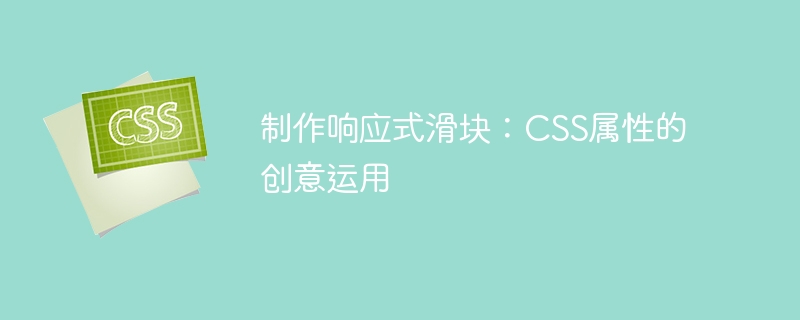

With the proliferation of mobile devices and desktop displays, building responsive websites has become increasingly important. In this process, the slider is a very common component, which can slide on the page to display different content or perform some operations. However, how to make a responsive slider is not that easy. This article explains how to use CSS properties to create a responsive slider and provides some specific code examples.
When designing a responsive slider, you need to consider many aspects, such as layout, color, animation, etc. There are many properties in CSS that can be used to build sliders. Some of the commonly used attributes are listed below:
When using a slider, the position and size of the slider are usually very important. CSS provides many properties to help us control the layout of the slider. The following are some commonly used attributes:
position: Control the positioning method of the element. You can use the valuesrelative,absoluteorfixed.top,left,right,bottom: Control the position of the slider in the parent element, you can use Relative or absolute units.width,height: Control the size of the slider, you can use relative or absolute units.Color is an integral part when building a slider. Here are some common CSS properties that can be used to set colors:
background-color: Sets the background color of the slider, using a color name, a hexadecimal value, or RGB value.borderandborder-radius: Set the border style and corner radius of the slider.box-shadow: Creates a shadow effect that can be used to optimize the appearance of the slider.The animation effect of the slider can have a good visual effect, which is very important for the user experience. The following are some commonly used CSS properties:
transition: Control the transition effect of the slider, you can set the transition properties, delay time and transition time.animation: Create animation effects, you can set the animation name, duration and animation method, etc.Here is a basic HTML and CSS code example for a horizontal slider:
.slider.horizontal { position: relative; width: 200px; height: 20px; } .slider .track { position: absolute; top: 50%; transform: translateY(-50%); width: 100%; height: 4px; background-color: #ddd; } .slider .thumb { position: absolute; top: 50%; transform: translateY(-50%); width: 20px; height: 20px; border-radius: 50%; background-color: #fff; box-shadow: 0px 2px 4px rgba(0, 0, 0, 0.1); transition: all 0.2s ease-in-out; } .slider:hover .thumb { transform: translateX(180px) translateY(-50%); }
In In this example, we use thepositionproperty to control the position of the slider and thumb, thebackground-colorproperty to set the color, and thetransitionproperty to create animation effects.
Here is a basic HTML and CSS code example for a vertical slider:
.slider.vertical { position: relative; width: 20px; height: 200px; } .slider.vertical .track { position: absolute; left: 50%; transform: translateX(-50%); width: 4px; height: 100%; background-color: #ddd; } .slider.vertical .thumb { position: absolute; left: 50%; transform: translateX(-50%); width: 20px; height: 20px; border-radius: 50%; background-color: #fff; box-shadow: 0px 2px 4px rgba(0, 0, 0, 0.1); transition: all 0.2s ease-in-out; } .slider:hover .thumb { transform: translateX(-50%) translateY(180px); }
In this example, we willwidthandheightattribute swap, use theleftandtransformattributes to control the position of the slider and thumb, use thetransitionattribute to Create animated effects.
In this article, we introduced how to make a responsive slider and provided some concrete code examples. These examples can help you quickly implement slider layout, colors, and animation effects. Of course, these properties are just a small part of CSS, and you can explore more CSS properties to create more unique slider effects.
The above is the detailed content of Making a responsive slider: Creative use of CSS properties. For more information, please follow other related articles on the PHP Chinese website!




